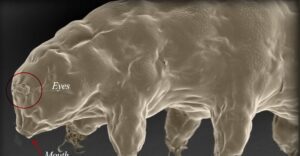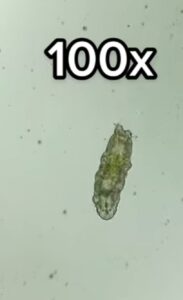
Few creatures have proven to be as hardy and fascinating throughout the enormous span of Earth’s history as tardigrades. These minuscule animals, sometimes referred to as moss piglets or water bears, have captivated the interest of scientists and amateurs alike because of their extraordinary resistance to harsh environments that would be lethal to the majority of other living things.
The origin of Tardigrades
The history of tardigrades is lengthy and illustrious, dating back millions of years—possibly even to the earliest phases of Earth’s formation. Although their precise beginnings are still unknown, fossil evidence indicates that tardigrades have been around for at least 500 million years, making them one of the planet’s oldest known animal species.These hardy organisms have withstood multiple mass extinctions, turbulent environmental changes, and sharp variations in climate. They have seen the ebb and flow of ancient oceans, the rise and fall of continents, and the development of mountain ranges. Tardigrades have persevered through it all, adjusting to any difficulties the natural environment has presented.

Anatomy of Tardigrades
In terms of both their physical characteristics and their biological adaptations, tardigrades are genuinely amazing microbes. When viewed under a microscope, they resemble small, fat bears with four pairs of short, sharply-tipped legs. Even though tardigrades are small the majority of them are less than one millimeter (0.1_1.1mm) long they have an intricate structure and physiology that allows them to live in a variety of habitats.
One of the most remarkable characteristics of tardigrades is their capacity to go into cryptobiosis.A state of suspended animation, in response to adverse environments. Tardigrades go through a number of physiological changes during cryptobiosis that enable them to withstand high temperatures, high pressure, desiccation, and even radiation exposure. Tardigrades can survive in this inactive state for years, decades until circumstances improve enough for them to begin a life.
Tardigrades and Environment conditions
Tardigrades can be found almost wherever on Earth, including the highest mountains, the deepest oceans, the arctic regions, and tropical rainforest .Their exceptional flexibility to a wide range of biological niches is demonstrated by the fact that they live in mosses, lichens, soil, freshwater, and marine environments.

The ability of tardigrades to live in harsh conditions that would be fatal to most other organisms is one of their most amazing achievements. They have been discovered to be thriving in both the frigid depths of Antarctica, where temperatures drop well below freezing, i’e -220°c and the hot springs of Yellowstone National Park, where temperatures can reach over 160°C.Experiments carried out on the International Space Station have shown that tardigrades may also survive in the vacuum of space.
Tardigrades demonstrated remarkable tendancy to face the hardship when they were subjected to the severe conditions of space, including high radiation levels, temperature swings, and vacuum pressure. This is due to their Genetic Secrets.
The peculiar genetic composition of tardigrades is the secret to their remarkable durability. In contrast to most other animals, tardigrades have an extremely unique genome that is full of genes linked to environmental protection, stress tolerance, and DNA repair.The ability of tardigrades to activate and deactivate certain genes in response to environmental stimuli is one of the most unique elements of tardigrade genetics. For example, tardigrades activate a set of genes that result in the production of “intrinsically disordered proteins.which are protective proteins that aid in stabilizing the cells and maintaining essential activities when exposed to desiccation.
Scientists are presently investigating tardigrade genomes with the aim of discovering the mechanisms behind their remarkable adaptability and utilizing this understanding in a range of domains, such as biotechnology, medicine, and astrobiology.In Popular Culture and Scientific Research, tardigrades
Despite their minuscule size, tardigrades have captivated people’s attention worldwide and evolved into recognizable icons of fortitude and perseverance.In the field of science, tardigrades are still fascinating and motivating for researchers who are trying to figure out the boundaries of life on Earth and beyond. Their capacity to endure in harsh conditions has significant skill and the possibility of extra terrestrial life.
Conclusion
Within the extensive fabric of Earth’s past, tardigrades are remarkable survivors who have persevered through hardship and overcome all odds. These little organisms have faced innumerable hardships, from the abyssal expanses of space to the profound depths of the seas, and they have learned to overcome all obstacles thrown their way by nature.A potent reminder of the resiliency and persistence of living things, tardigrades are as we continue to investigate the secrets of life on Earth and beyond. Their tale serves as a monumen
Few creatures have proven to be as hardy and fascinating throughout the enormous span of Earth’s history as tardigrades. These microbe’s sometimes referred to as moss piglets or water bears, have captivated the interest of scientists and amateurs alike because of their extraordinary resistance to harsh environments that would be lethal to the majority of other living things.


Your article helped me a lot, is there any more related content? Thanks!